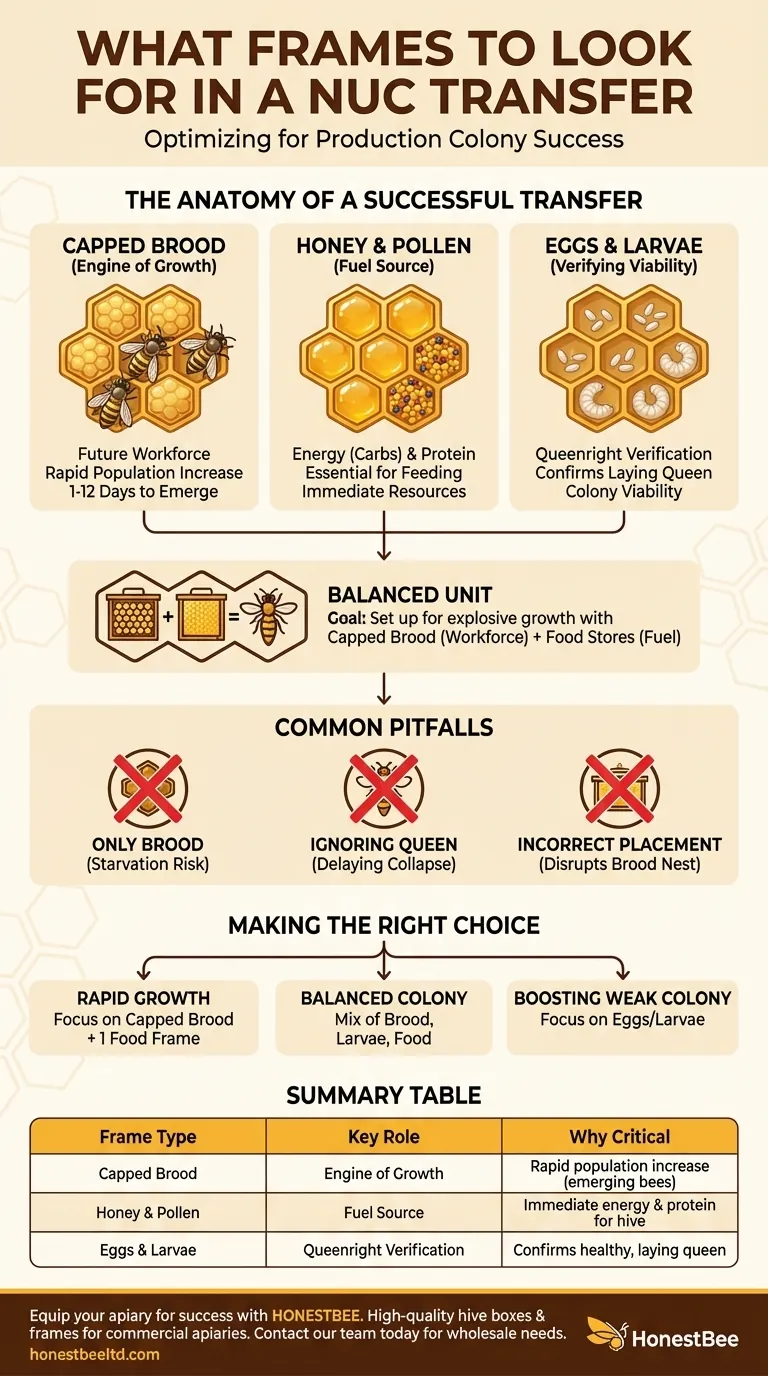When transferring a nucleus colony (nuc), you must prioritize frames that contain a high concentration of capped brood and the bees covering them. These frames represent the next generation of worker bees and are the single most important factor for rapidly increasing the colony's population. To ensure this new population can thrive, it is also critical to include frames with adequate food stores, specifically honey and pollen.
Your goal is not simply to move bees, but to set the new colony up for explosive growth. The best approach is to transfer a balanced unit: capped brood to provide the future workforce, and food stores to fuel the queen's laying and feed the emerging bees.

The Anatomy of a Successful Transfer
Transferring a nuc is a strategic task. Each frame you select serves a specific purpose in establishing a strong, self-sufficient colony. Understanding the role of each component is key.
The Engine of Growth: Capped Brood
The most valuable frames in your nuc are those filled with capped brood. These are the pupating bees that will emerge within 1 to 12 days.
A dense pattern of capped brood is a direct investment in the colony's near-future population. A massive hatch of new workers is what allows the colony to quickly begin drawing new comb, foraging for resources, and caring for the next generation of brood.
The Fuel Source: Honey and Pollen
A frame containing honey and pollen is the colony's pantry. Honey provides the carbohydrates (energy) needed for all hive activities, while pollen provides the protein essential for feeding larvae.
Transferring a nuc into a large, empty hive box without a ready food source can be a fatal shock. The bees must have immediate access to resources to feed themselves and the new brood the queen will begin laying.
Verifying Viability: Eggs and Larvae
While capped brood builds future population, a frame with eggs and open larvae serves a different, vital function: it proves the colony is queenright.
Seeing fresh eggs, which look like tiny grains of rice at the bottom of a cell, is the definitive sign that a healthy, laying queen is present. This confirms the colony is viable and has a leader to guide its expansion.
Understanding the Trade-offs and Common Pitfalls
Focusing only on one type of frame can compromise the success of the transfer. Avoiding these common mistakes is as important as knowing what to look for.
Pitfall: Prioritizing Only Brood
It is a mistake to transfer only brood frames while leaving the food behind. A colony with thousands of emerging bees and a productive queen but no pantry can starve in a matter of days, especially if poor weather prevents foraging.
Pitfall: Ignoring the Queen's Status
Never assume a nuc is queenright. Before moving frames, take a moment to find the queen or, more realistically, confirm the presence of freshly laid eggs. Transferring a queenless colony is simply delaying its collapse.
Pitfall: Incorrect Frame Placement
The order of frames in the new hive matters. The brood frames should be placed together in the center of the new box. This allows the bees to cluster efficiently and maintain the critical temperature and humidity of the brood nest. Flank the brood frames with frames of food.
Making the Right Choice for Your Goal
Your primary objective will influence which frames you prioritize.
- If your primary focus is rapid population growth for honey production: Prioritize the frames with the largest, most compact patterns of capped brood, but ensure you bring at least one solid frame of honey and pollen.
- If your primary focus is creating a balanced, stable colony: Select a mix that mirrors a healthy hive—one or two frames of mostly capped brood, one frame with the queen and open larvae, and one or two frames of food.
- If you are boosting a weak colony: Your priority is a frame with fresh eggs and young larvae, which gives the colony the resources to either raise a new queen or immediately support their existing one.
By strategically selecting your frames, you are not just moving bees; you are setting the foundation for a thriving and productive colony.
Summary Table:
| Frame Type | Key Role in Transfer | Why It's Critical |
|---|---|---|
| Capped Brood | Engine of Growth | Provides a wave of new worker bees (emerging in 1-12 days) for rapid population increase. |
| Honey & Pollen | Fuel Source | Supplies immediate energy (carbs) and protein to feed the colony and support brood rearing. |
| Eggs & Larvae | Queenright Verification | Confirms a healthy, laying queen is present, ensuring colony viability. |
Equip your apiary for success with HONESTBEE. A smooth nuc transfer relies on high-quality equipment to protect your valuable brood and food frames. As a trusted wholesale supplier for commercial apiaries and beekeeping equipment distributors, we provide the durable hive boxes, frames, and tools you need to build strong, productive colonies. Let's discuss your wholesale needs – contact our team today to ensure your operations are built on a solid foundation.
Visual Guide

Related Products
- 5 Frame Wooden Nuc Box for Beekeeping
- Plastic Transporting Bee Packages and Nuc Boxes for Beekeeping
- Portable Bee Mating Hive Boxes Mini Mating Nucs 8 Frames for Queen Rearing
- Professional Insulated Plastic Bee Hives
- HONESTBEE Professional Multi-Functional Hive Tool with Ergonomic Wood Handle
People Also Ask
- What are the benefits of starting a new bee colony in a nuc box? Boost Colony Success with Efficient Beekeeping
- What frames should be moved into the queenless hive when requeening with a nuc? Ensure a Successful Queen Introduction
- What are the benefits of using nucs for beginning beekeepers? Ensure a Successful First Hive with a Head Start
- What are the benefits of moving nuclei around the apiary? Master Strategic Hive Management
- How should the nuc be installed in the apiary? Ensure Colony Success from Day One



















